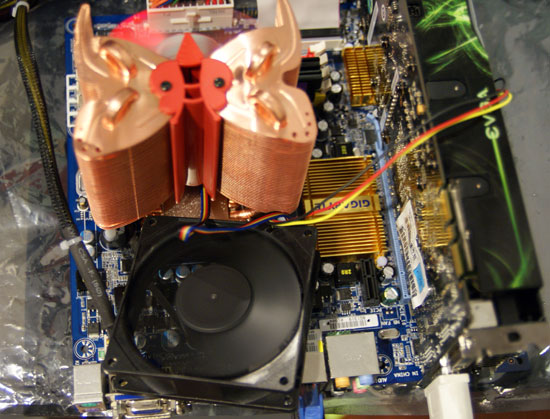AMD's Phenom X4 9950, 9350e and 9150e: Lower Prices, Voltage Tricks and Strange Behavior
by Anand Lal Shimpi & Gary Key on July 1, 2008 12:00 AM EST- Posted in
- CPUs
More Problems?
The Phenom’s flaky Cool'n'Quiet performance in some of our benchmarks forced us to test with it disabled, unfortunately with it disabled we ran into another problem: stability.
Gary originally wrote about this in his Postcards from the Edge blog. Many mainstream motherboards ship with low cost 3-phase power delivery circuitry, which is unfortunately insufficient to handle the current draw of AMD’s very high end 125W and 140W TDP processors. Despite the problems Gary initially encountered with many early boards (both AMD and Intel platforms), many manufacturers continue to certify 125W processors like the Phenom X4 9850 BE on their mainstream boards.
While it’s unlikely that a user would drop a 9850 into a 780G motherboard, it is possible that someone would take a Phenom X4 9550 and attempt to overclock it too far on a 780G - resulting in the same problems.
With Cool'n'Quiet enabled, our power load on our testbed Gigabyte 780G was just fine - the motherboard had no problems uneventfully completing our entire test suite. However, with CnQ disabled as we had to do in order to get the best performance results out of Phenom our 780G board was noticeably less stable. While it completed most tests without issue, we couldn't complete a run of Windows Media Encoder 9 without cooling the power delivery circuitry on the motherboard. A simple case fan did the trick:

The Cool'n'Quiet issues we encountered clearly have much further reaching implications than erratic performance in a few benchmarks.










36 Comments
View All Comments
Gikaseixas - Wednesday, July 2, 2008 - link
Other sites tested it already and could hit 3.2 - 3.6 speeds. Hopefully Anandtech will be able to overclock a Phenom to it's limits this time around.Googer - Wednesday, July 2, 2008 - link
Missing from the benchmarks is the Intel Core 2 Quad Q9550 Yorkfield 2.83GHz 12MB. How would this chip stack up against all others tested?http://www.newegg.com/Product/Product.aspx?Item=N8...">http://www.newegg.com/Product/Product.aspx?Item=N8...
RamarC - Wednesday, July 2, 2008 - link
the q9550 isn't in the same price range as the other processors so that's why it wasn't included. as for performance, either subtract or add 10% to the q9450's figures.DanD85 - Wednesday, July 2, 2008 - link
Are you absolutely sure about that? As hothardware thinks differently:"By altering its multiplier and increasing the CPU voltage to 1.45v, we were able to take our Phenom X4 9950 to an respectable 3.1GHz using nothing but a stock AMD PIB cooler. Higher frequencies were possible, but we couldn't keep the system 100% stable, so we backed things down to 3.1GHz. While running at that speed, we re-ran some tests and also monitored core temperatures and found that the chip never broke the 60ºC mark, and hovered around 58ºC under load - at least according to AMD's Overdrive software. That is one heck of an overclock and relatively cool temperatures for a Phenom in our opinion. If the majority of chips have the same amount of headroom as ours, we suspect the 9950 Black Edition will be appealing to AMD CPU enthusiasts looking for the best the company has to offer."
http://www.hothardware.com/Articles/AMD_Phenom_X4_...">http://www.hothardware.com/Articles/AMD...nom_X4_9...
KaarlisK - Wednesday, July 2, 2008 - link
Maybe by setting affinity for Photoshop's threads to a certain core, it would be possible to verify whether Vista's thread management is part of the cause?Zoomer - Wednesday, July 2, 2008 - link
I know its a novel concept, but what about running some benches in XP to see if it's another Vista issue?Rhoxed - Wednesday, July 2, 2008 - link
Increasing the NB core (IMC) clock (in Phenom it runs async from the Core Speed unlike Athlon which is Sync) drops latencies (especially L3) and increases memory performance/throughput, which in turn improves system performance. The Phenom starts to come to life when you hit a 2.6GHz core speed with a NB core clock at 2200MHz+. Depending on the application and CPU, increasing NB core speeds (getting up to 2200MHz+) can result in performance differences from 3%~12% in most cases.Upping my NB/HT to 2400MHz over the stock 2000 at the same clockspeed (2800) i net a 15%~ increase (on a 9850BE)
RamarC - Tuesday, July 1, 2008 - link
i'm a developer and want to upgrade my win2k3/ss2k5 server to a quad core. since it currently has a 3.4ghz p4d, a phenom 9x50 would be a big step-up (even though i don't have any performance issues). but the p4d has been very reliable and i don't want to have to deal with flaky hardware issues when i'm pushing code out the door. should i just bite the bullet and shell out the extra cash for a p45+q9450?Calin - Wednesday, July 2, 2008 - link
I have an AMD based PC at home, and I look forward to another AMD-based pc (780G and Phenom X3 or X4).These being said, I think for a server you really really should go for an Intel configuration. Also, at 3.4 GHz a P4D probably is one hell of a power draw.
Compared to your current server, and based on what I think you need, I don't think a quad core would help you - a dual core would probably be enough, and Intel has those aplenty.
Zoomer - Wednesday, July 2, 2008 - link
From the article, it seems like sticking to the cheaper, sub 100W TDP cpus and not overclocking is the way to go.